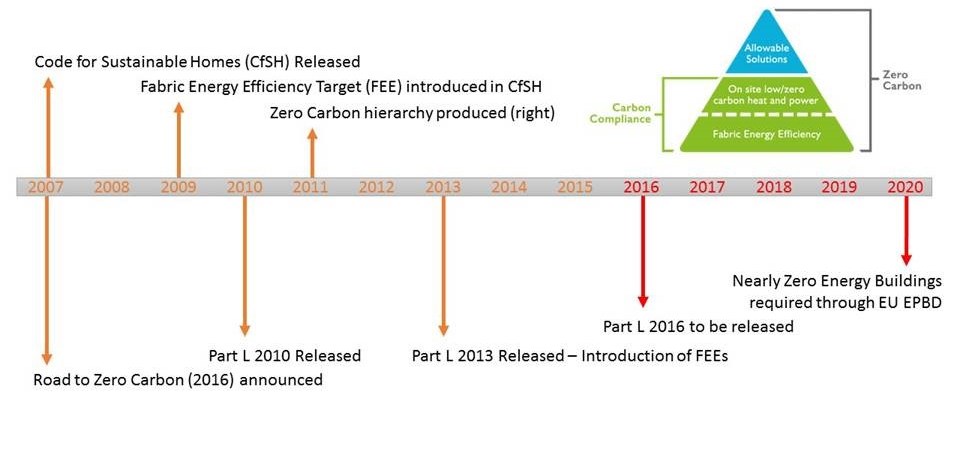|
The Government has recently released a document called the Productivity Plan. This plan essentially sets how it plans to become more productive, i.e. how it is looking to streamline over the term and fix the foundations holding up the Government. The changes are proposed across many sectors, however there is one sentence (under section 9.17) that stands out amongst the crowd and that impacts on the future of sustainability in building. Termed as extended its ‘success’ in reducing net regulations on house builders, the changes are aimed at speeding up the rate of housebuilding and are as follows: ‘The government does not intend to proceed with the zero carbon Allowable Solutions carbon offsetting scheme, or the proposed 2016 increase in on-site energy efficiency standards, but will keep energy efficiency standards under review, recognising that existing measures to increase energy efficiency of new buildings should be allowed time to become established. ’ This is a disappointing blow for the construction industry that has been gearing up for zero carbon homes from next year, since it was first announced in 2007. This announcement does not just effect zero carbon homes, zero carbon non-domestic buildings will also get the chop from 2019. So what is actually changing? Allowable Solutions Allowable solutions were supposed to be the stop gap between regulation and zero carbon. Where zero carbon couldn’t be achieved on site, allowable solutions could enables carbon offsetting via over means. This was likely to involve a low carbon fund where a price was paid per tonne of carbon, with this fund supporting low or zero carbon communal or district energy solutions. Whilst an additional cost to the industry, this was widely heralded as a good solution that effectively produced zero carbon buildings by providing decentralised decarbonised energy. Although it is possible that Allowable solutions may form part of a low carbon regulation in the future, it will not be introduced as planned in 2016. |
Part L 2016 The big change here is that it seems that the intention is not to make any changes to Part L in 2016. The idea from the government here is that by keeping legislation the same it will allow the industry to get used to the changes and allow greater confidence which will turn into more housing. The reality is though, that industry has had these changes in its sights for the last 8 or 9 years, the changes to Part L were not going to a shock to anybody. What this change actually does in reality to devalue the hard work that house builders and designers have been doing to gear themselves up for the changes, in an open letter to the Chancellor, 246 of industry leaders have said that this U turn in the eleventh hour ‘ undermined industry confidence in the Government and will now curtail investment in British innovation and manufacturing ’. Nearly Zero Energy Buildings With the effective death of zero carbon buildings, the next driver for Part L is the policy coming out of the EU’s Energy Performance of Buildings Directive (EPBD), which puts requirements on member states to deliver nearly zero energy buildings from 2020. In effect this means that public sector buildings will have to be compliant by 2019 and all buildings from 2021. The UK has not yet set out how it plans on meeting the requirements, however, the emphasis will be on constructing a better building fabric, which may be along the same lines as the Passivhaus methodology. This requirement of course is subject to the EU Referendum on UK membership So, the path for sustainability in the industry over the next few years is changing. The government thinks that this will help stimulate housebuilding however with reduced confidence in the Government this may or may not bear fruit. What is certain is that the Government’s appetite for a sustainable future is not as high as its predecessors and we may find that the UK is giving up on being a leader in this field. |
|
 |
||
- our practice
- Our People
- our services
- Architecture
- Building Surveying
- Building Services Engineering
- Planning
- Interior Design
- Sustainability
- Civil Engineering
- Structural Engineering
- Quantity Surveying
- Project Management
- CDM and H&S Services
- The Building Safety Act
- What is the Building Safety Act?
- Does the Building Safety Act apply to all buildings?
- What are the key changes to the Building Safety Act?
- Changes to the Building Regulations
- What does the Building Regulations Client have to do?
- Who is the Accountable Person?
- How do I prepare for Building Safety Act changes?
- transport and infrastructure
- our sectors
- our projects
- news & socials





 General Enquiries
General Enquiries Twitter
Twitter LinkedIn
LinkedIn Instagram
Instagram